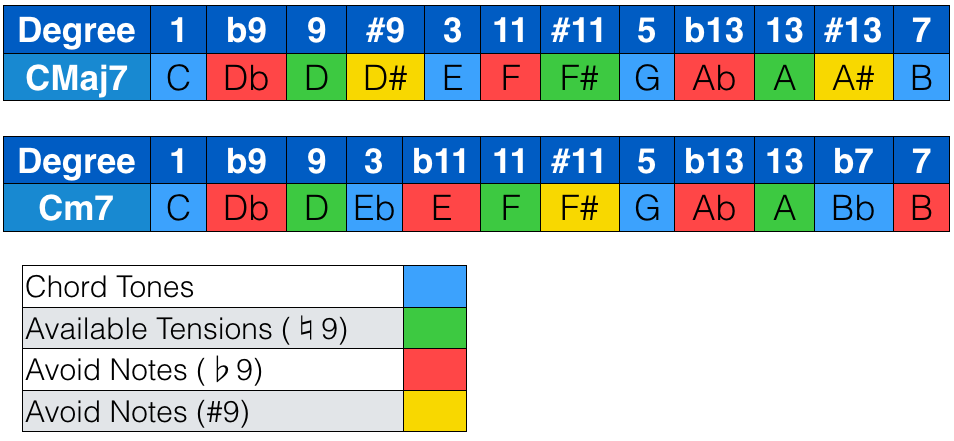Introduction
We have already encountered Avoid Notes many times in previous lessons. So it’s time we formally define them. Much like there are harmonically ‘strong’ notes within a scale (Guide Tones), there are also harmonically ‘weak’ notes. These notes are called Avoid Notes.
Avoid Notes
Avoid Notes sound dissonant and unpleasant against a particular chord as they clash with the harmony. They can, of course, be used as passing notes, but should NOT be overemphasised or sat on for too long, as this will make your solo sound dissonant and weak.
Technically, an avoid note is any note that is one semitone above a chord tone (in a scale). They vary depending on the chord and scale being used. Below is a table of all the avoid notes found in the Major scale over each chord derived in a Major key, from the root note of C.
| Degree | Mode | Chord | Avoid Note | Avoid Note Degree |
|---|---|---|---|---|
| I | C Ionian | CMaj7 | F | 4 |
| ii | D Dorian | Dm7 | None | None |
| iii | E Phrygian | Em7 | C & F | ♭2 & ♭6 |
| IV | F Lydian | FMaj7 | None | None |
| V | G Mixolydian | G7 | C | 4 |
| vi | A Aeolian | Am7 | F | ♭6 |
| vii | B Locrian | Bm7♭5 | C | ♭2 |
(Aside: Some people believe the 6th in the Dorian mode is an avoid note over a m7 chord (B in the above example) because it is a tritone (another dissonant interval) above the 3rd of the chord (F in the above example). I disagree (avoid notes are a little subjective). For the purposes of this lesson and all past and future lessons, let’s say the Dorian mode does NOT have avoid notes and therefore B is NOT an avoid note).

If it’s easier for you, an approximate rule of thumb is:
- On Maj7 & V7 Chords – Avoid the 4th
- On m7 Chords – Avoid the 6th
- On Half-Diminished Chords – Avoid the 2nd & 6th
Avoid Notes can be used to build tension and as such can be used as an improvisation technique, but do ensure that you resolve them nicely.
(Both ‘unavailable tension’ and ‘avoid note’ relate to notes that create a dissonant interval with one of the chord tones (which is why I use them synonymously), but ‘unavailable tensions’ are in the context of chords while ‘avoid notes’ are in the context of scales).
More Avoid Notes
The concept of avoid notes can be expanded beyond just the major scale to cover all 12 notes. We have already covered this concept in our lesson on available tensions, but let’s quickly revisit and expand upon the concepts. We can divide all 12 notes into three categories:
- Chord Tones – the notes of the chord (root, 3, 5, 7)
- Available Tensions – notes that complement the sound of a chord (these are typically a ♮9 above a chord tone, for Maj7 and min7 chords)
- Avoid Notes – notes that clash with the sound of a chord (traditionally, these are those notes that create a ♭9 or #9 interval with a chord tone for, Maj7 and min7 chords).
Maj7 and min7 chords are considered quite consonant, so we only want to add consonant intervals to these chords. This means we only add tensions that are a ♮9 above each chord tone. Both the ♭9 or #9 intervals were traditionally considered too dissonant to add to the Maj7 and min7 chords. But not all dissonant intervals are equal. The ♭9 interval is considered much more dissonant that the #9 interval. For this reason, more contemporary musicians have began adding tensions a #9 above a chord tone. Indeed, you may occasionally come across a Maj7#9 chord (this is often played a VII/I slash chord, such as a B/C). While this chord is still a bit unusual and a bit dissonant, it is becoming more and more acceptable. This is how music and our taste for dissonance evolves. I will have more to say about this in a future lesson. Below is a table which categorises each of the 12 notes. While both the red and yellow notes are considered ‘avoid notes, the yellow avoid notes are today slightly more acceptable than the red ones.

Have a Listen to
The following songs contain a VII/I slash chord (e.g. B/C) which equates to a Maj7#9 chord.
- Miles Davis – Four (last chord of the song)
- Miles Davis – If I Were a Bell (last chord of the song)
- John Coltrane – I Wish I Knew
- Kenny Barron – I’m Gettin’ Sentimental Over You
For those of you who are interested in learning a bit more about avoid notes, check out the below video.